Typhoon Haiyan in Pictures
 An aerial shot Saturday of Tacloban Airport that was devastated by powerful typhoon Haiyan in the Philippines Friday. Meteorologists said Haiyan had maximum sustained winds of 314 kilometers per hour (195 mph) and gusts up to 379 kilometers per hour (235 mph). AP Photo/Bullit Marquez
An aerial shot Saturday of Tacloban Airport that was devastated by powerful typhoon Haiyan in the Philippines Friday. Meteorologists said Haiyan had maximum sustained winds of 314 kilometers per hour (195 mph) and gusts up to 379 kilometers per hour (235 mph). AP Photo/Bullit Marquez Survivors assess the damage after super Typhoon Haiyan battered Tacloban city.
REUTERS/Romeo Ranoco
Survivors assess the damage after super Typhoon Haiyan battered Tacloban city.
REUTERS/Romeo Ranoco A vehicle lies amid debris caused by powerful typhoon Haiyan that hit Tacloban city, in Leyte province in central Philippines.
AP Photo/Bullit Marquez
A vehicle lies amid debris caused by powerful typhoon Haiyan that hit Tacloban city, in Leyte province in central Philippines.
AP Photo/Bullit Marquez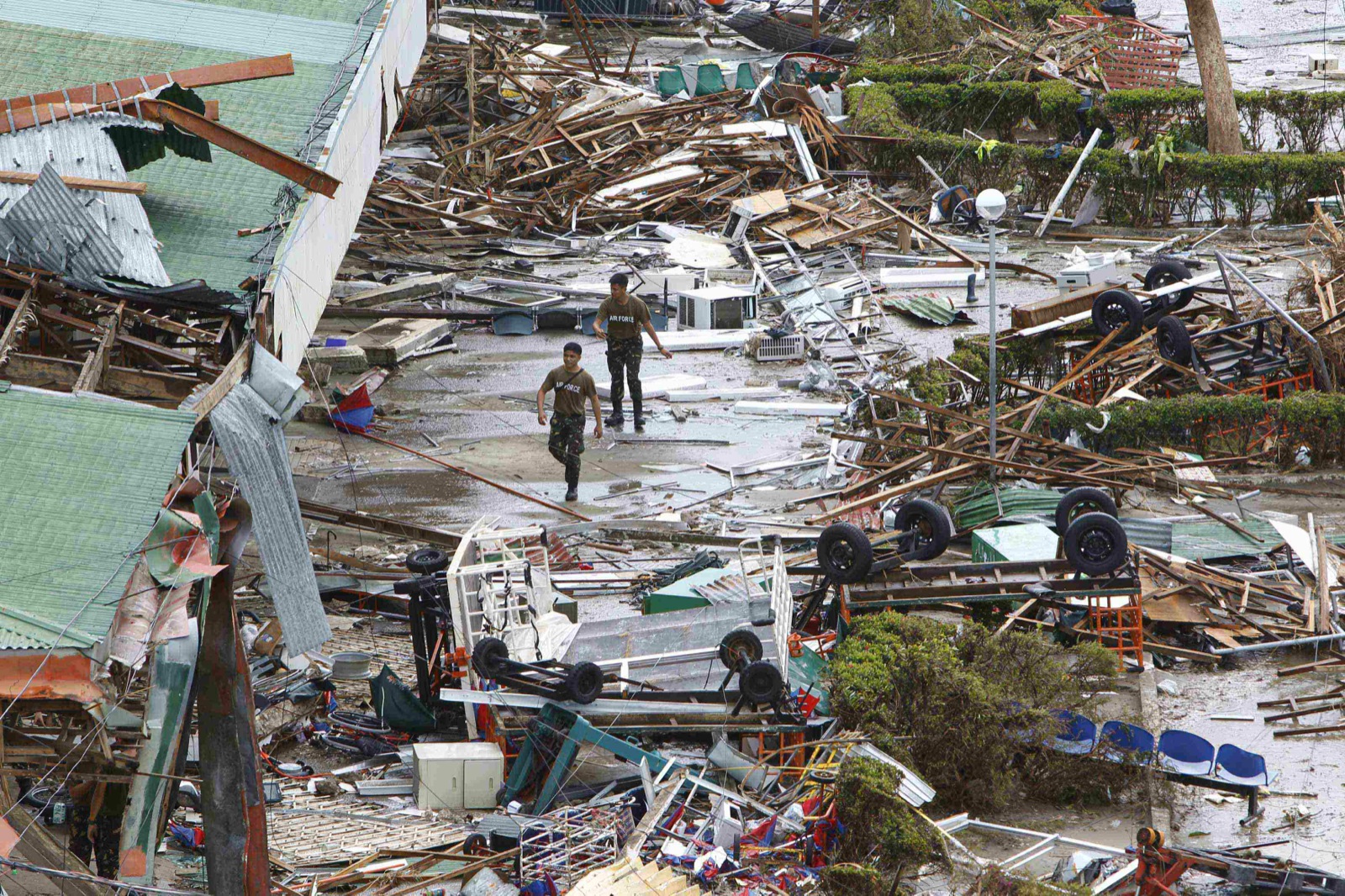 Soldiers walks past the damaged area of an airport after super Typhoon Haiyan battered Tacloban city.
REUTERS/Romeo Ranoco
Soldiers walks past the damaged area of an airport after super Typhoon Haiyan battered Tacloban city.
REUTERS/Romeo Ranoco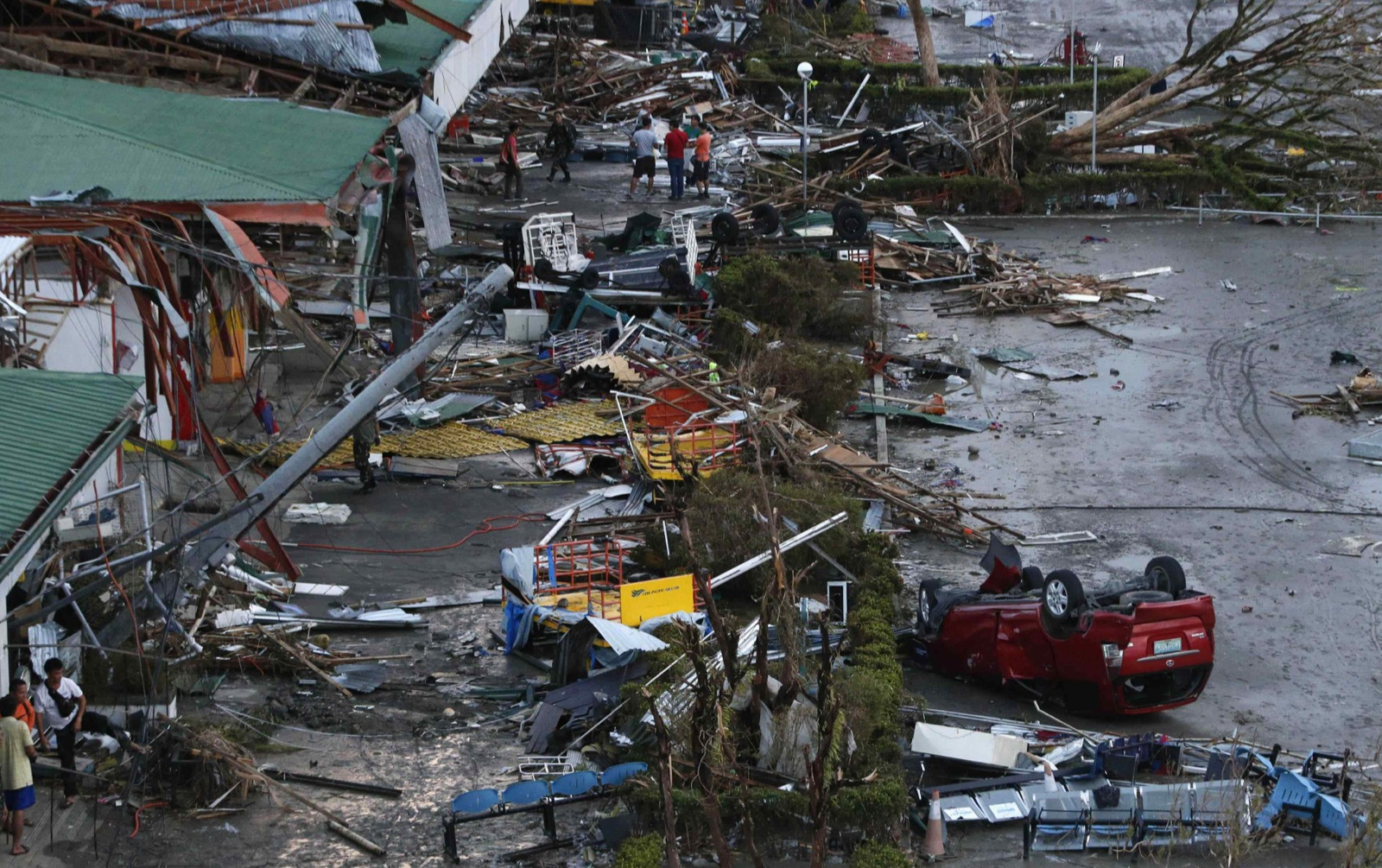 Debris litters a damaged airport. Possibly the strongest typhoon ever to hit land, Haiyan devastated the central Philippine city of Tacloban, killing at least 100 people.
REUTERS/Erik De Castro
Debris litters a damaged airport. Possibly the strongest typhoon ever to hit land, Haiyan devastated the central Philippine city of Tacloban, killing at least 100 people.
REUTERS/Erik De Castro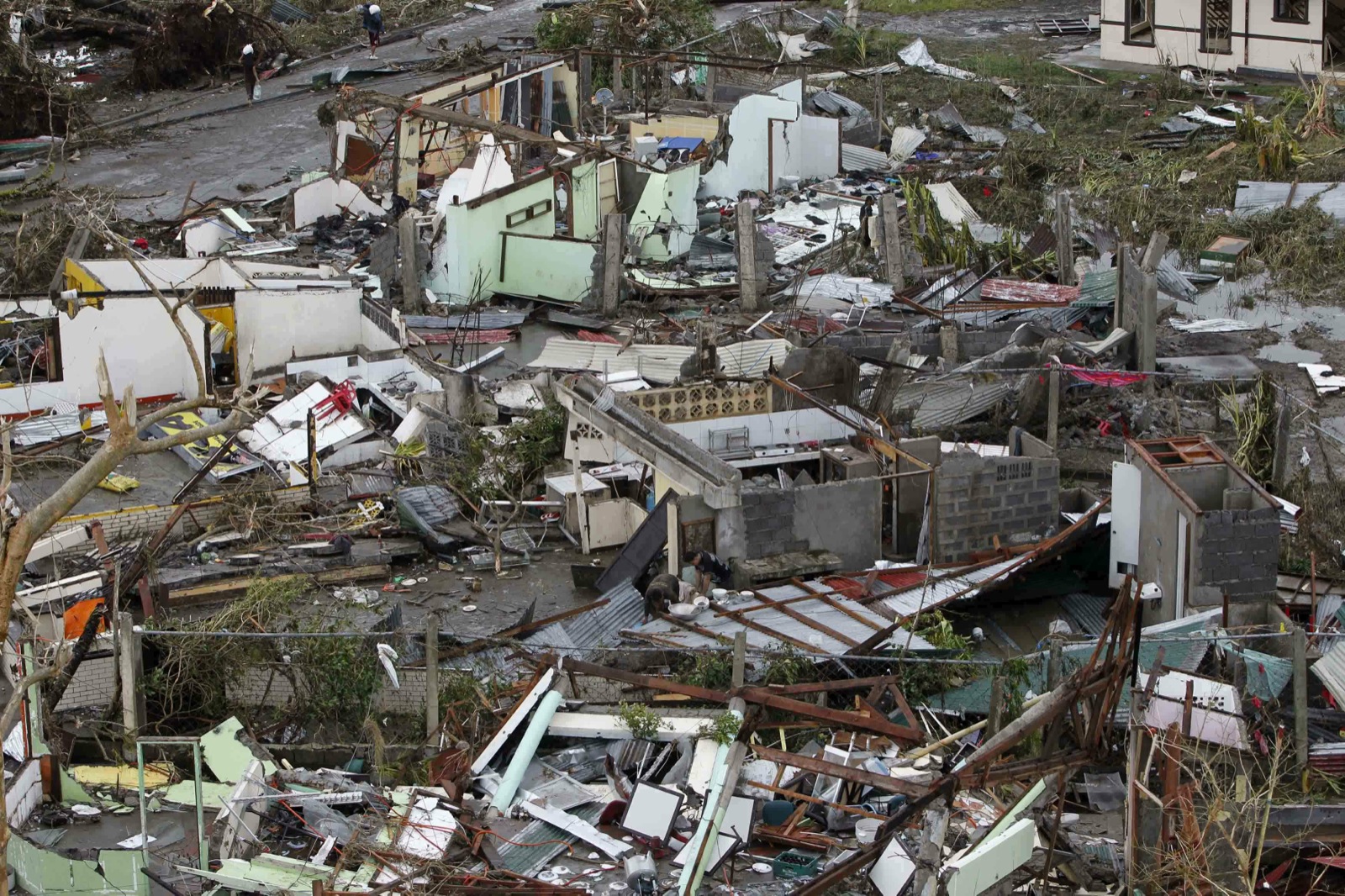 Damaged houses near the airport.
REUTERS/Romeo Ranoco
Damaged houses near the airport.
REUTERS/Romeo Ranoco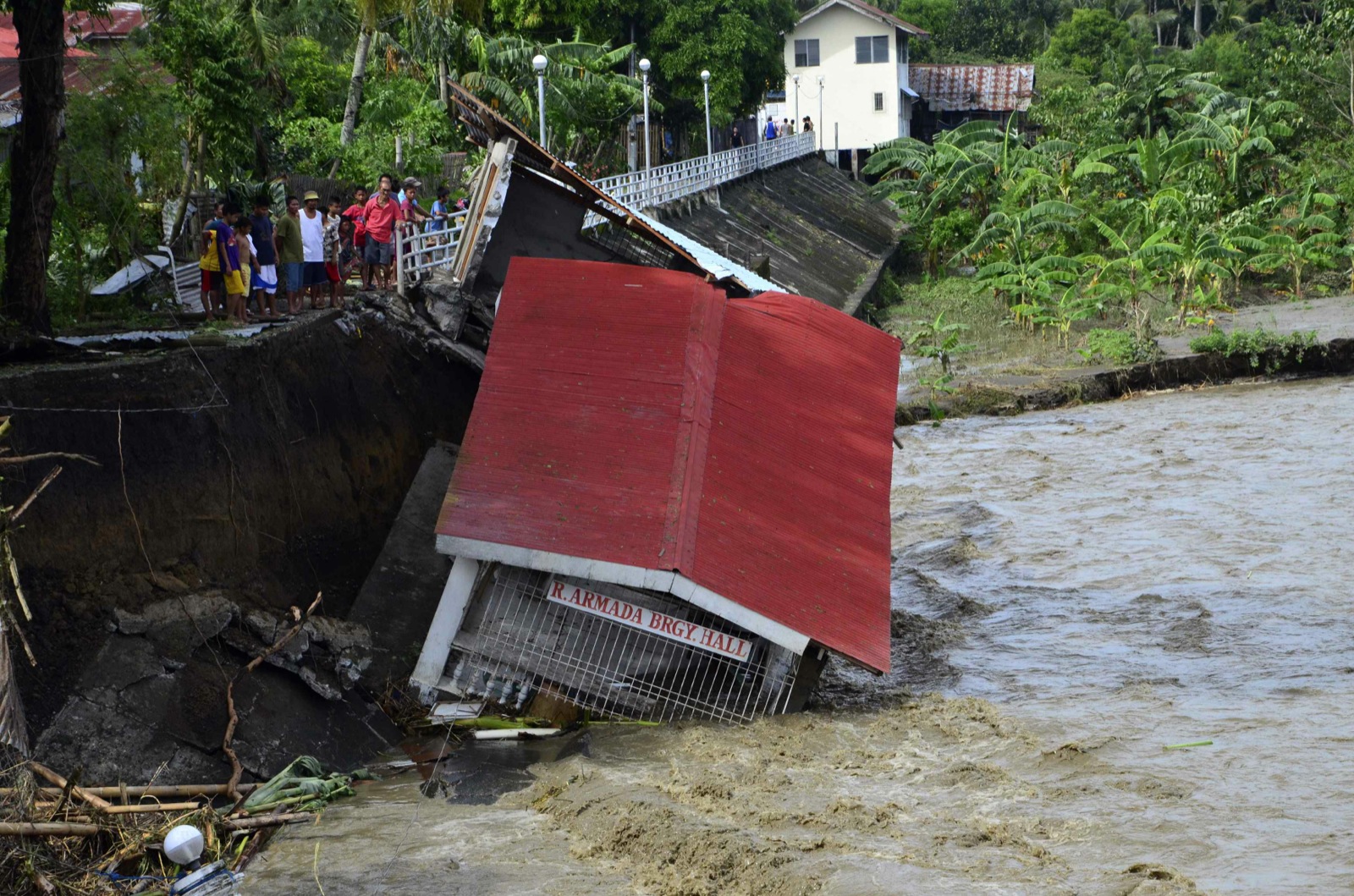 Residents look at the damaged village hall after Typhoon Haiyan hit Janiuay, in Iloilo province in central Philippines.
REUTERS/Nereo Lujan
Residents look at the damaged village hall after Typhoon Haiyan hit Janiuay, in Iloilo province in central Philippines.
REUTERS/Nereo Lujan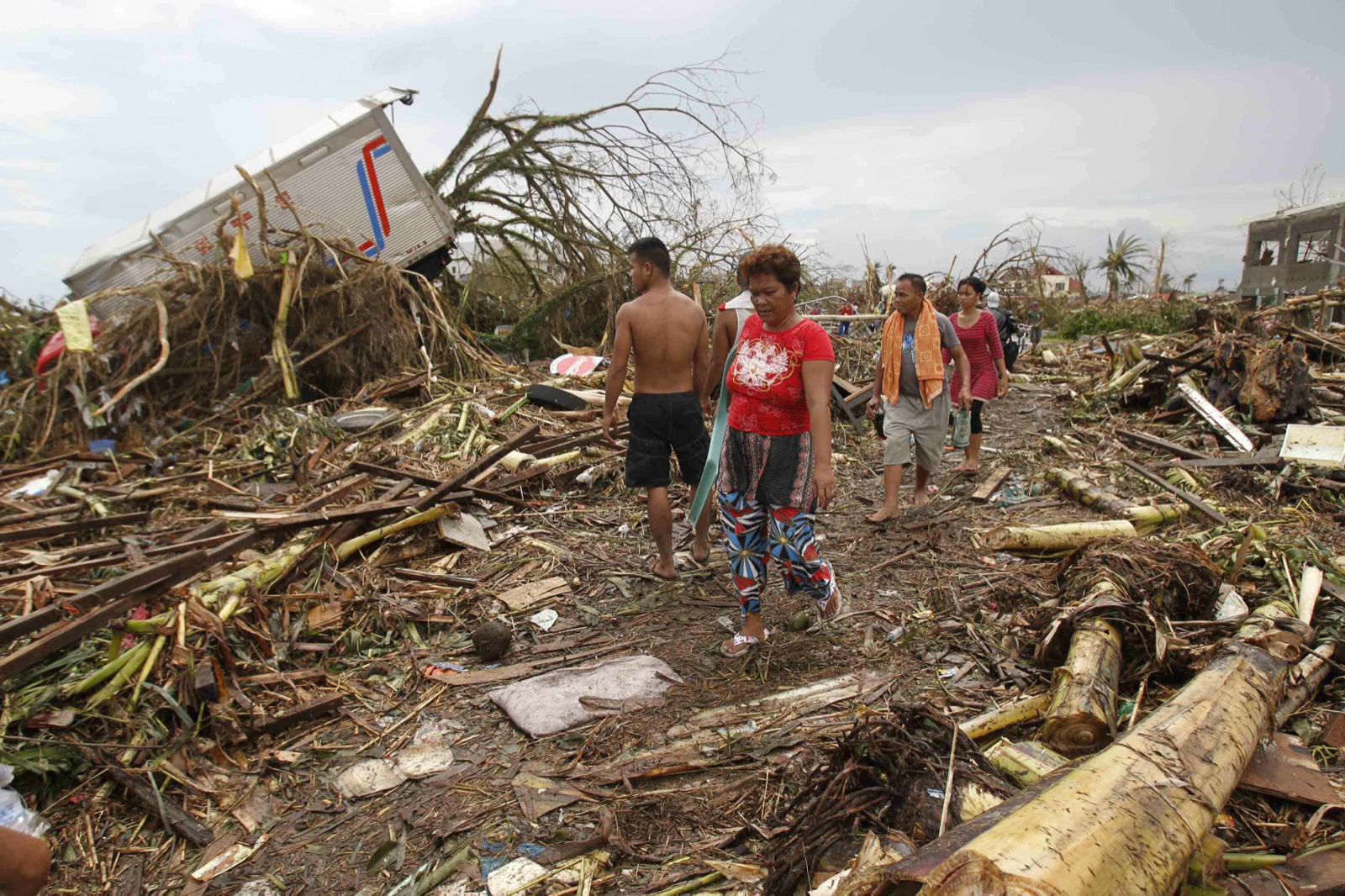 Residents walks past a truck that slammed into a tree after a super Typhoon Haiyan battered Tacloban city.
REUTERS/Romeo Ranoco
Residents walks past a truck that slammed into a tree after a super Typhoon Haiyan battered Tacloban city.
REUTERS/Romeo Ranoco Children play near electric posts that were damaged after super Typhoon Haiyan battered Tacloban city.
REUTERS/Romeo Ranoco
Children play near electric posts that were damaged after super Typhoon Haiyan battered Tacloban city.
REUTERS/Romeo Ranoco Women walk past fallen trees and destroyed houses in the aftermath of Super Typhoon Haiyan in Tacloban.
NOEL CELIS/AFP/Getty Images
Women walk past fallen trees and destroyed houses in the aftermath of Super Typhoon Haiyan in Tacloban.
NOEL CELIS/AFP/Getty Images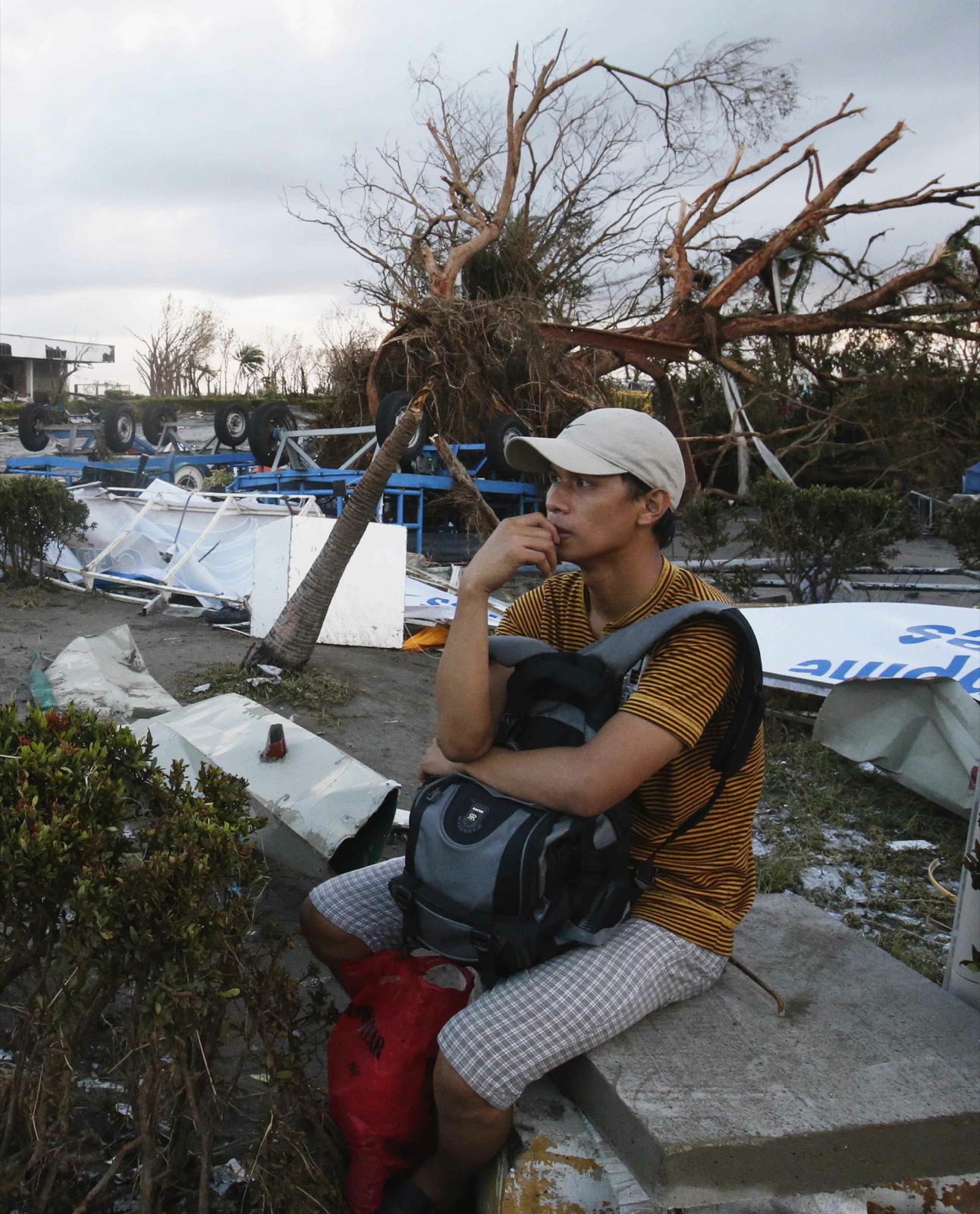 A survivor waits for a military mercy flight outside a damaged airport after super Typhoon Haiyan battered Tacloban city.
REUTERS/Erik De Castro
A survivor waits for a military mercy flight outside a damaged airport after super Typhoon Haiyan battered Tacloban city.
REUTERS/Erik De Castro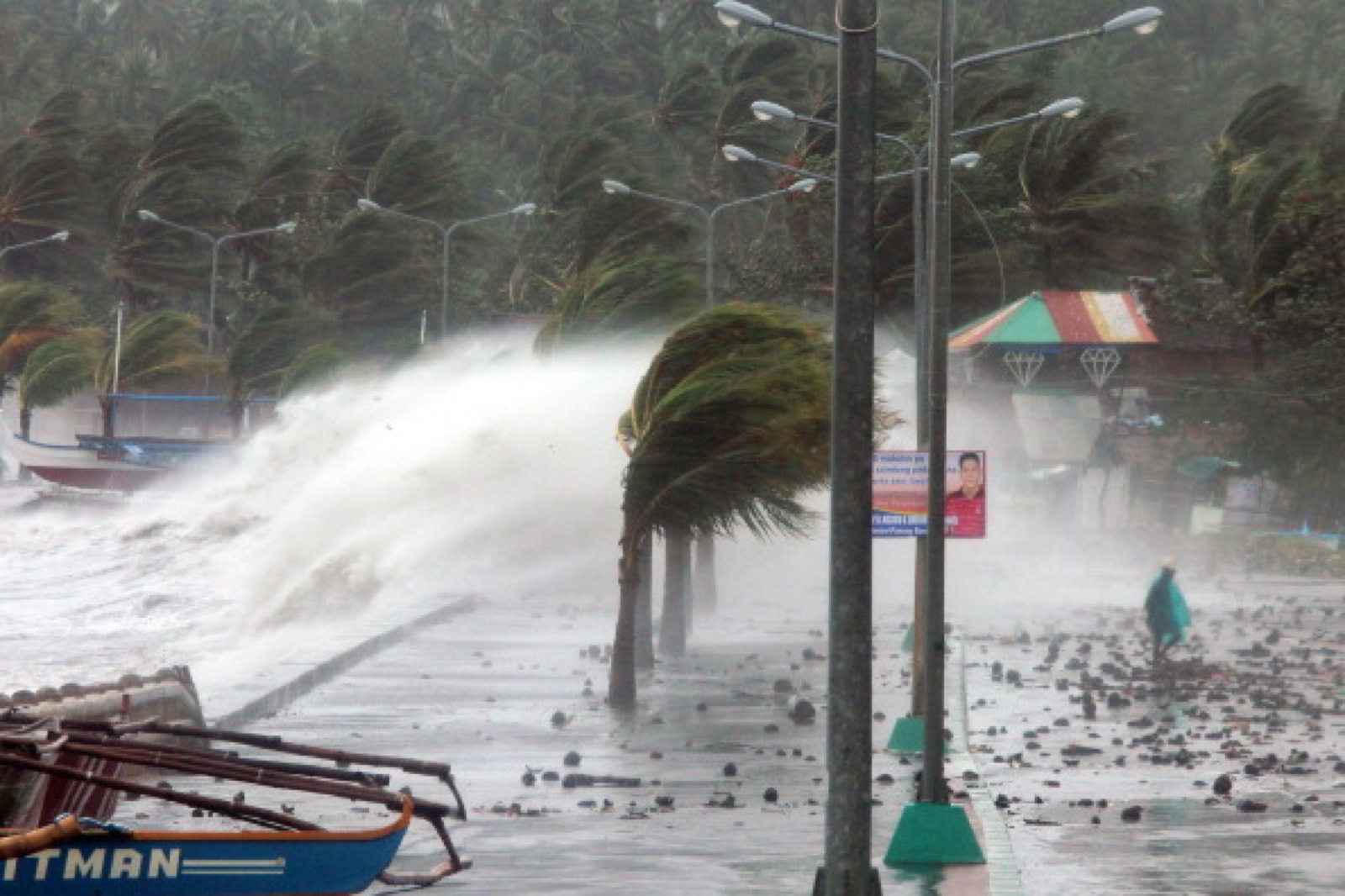 A resident, right, walks past high waves pounding the sea wall amid strong winds as Typhoon Haiyan hit the city of Legaspi, Albay province, south of Manila on Friday. One of the most intense typhoons on record terrified millions as monster winds tore roofs off buildings and giant waves washed away flimsy homes.
Charism SAYAT/AFP/Getty Images
A resident, right, walks past high waves pounding the sea wall amid strong winds as Typhoon Haiyan hit the city of Legaspi, Albay province, south of Manila on Friday. One of the most intense typhoons on record terrified millions as monster winds tore roofs off buildings and giant waves washed away flimsy homes.
Charism SAYAT/AFP/Getty Images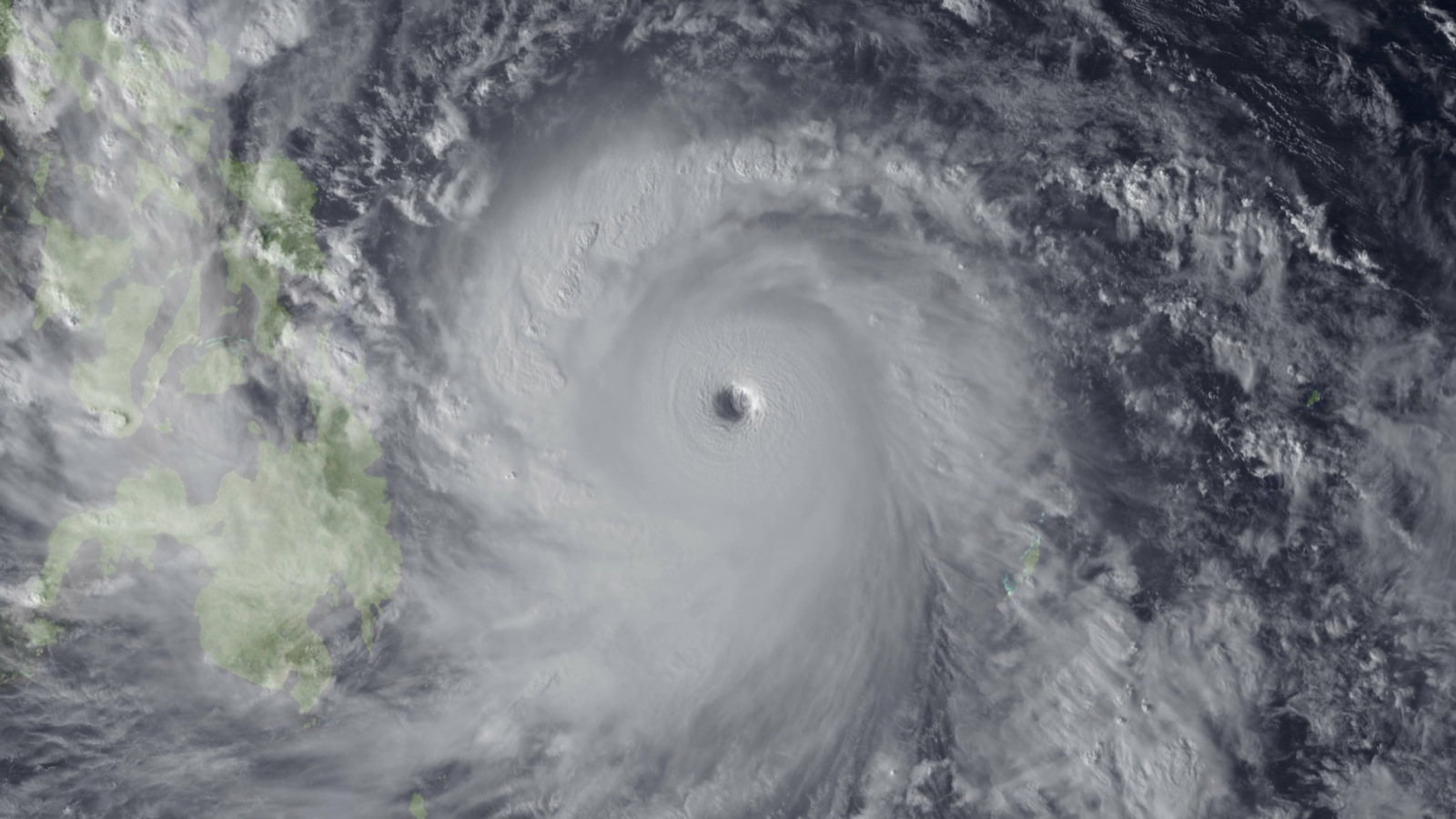 Super Typhoon Haiyan is seen approaching the Philippines in this Japan Meteorological Agency handout image taken Thursday. Authorities in the Philippines grounded air and sea transport on Thursday and urged fishing boats to return to port. With center winds of 215 kph (133 mph) and gusts of up to 250 kph, the storm, was rated as category 5.
REUTERS/Japan Meteorological Agency/NOAA/Handout
Super Typhoon Haiyan is seen approaching the Philippines in this Japan Meteorological Agency handout image taken Thursday. Authorities in the Philippines grounded air and sea transport on Thursday and urged fishing boats to return to port. With center winds of 215 kph (133 mph) and gusts of up to 250 kph, the storm, was rated as category 5.
REUTERS/Japan Meteorological Agency/NOAA/Handout Fishermen secure their boats in anticipation of the arrival of Typhoon Haiyan near Manila Bay, Friday.
REUTERS/Erik De Castro
Fishermen secure their boats in anticipation of the arrival of Typhoon Haiyan near Manila Bay, Friday.
REUTERS/Erik De Castro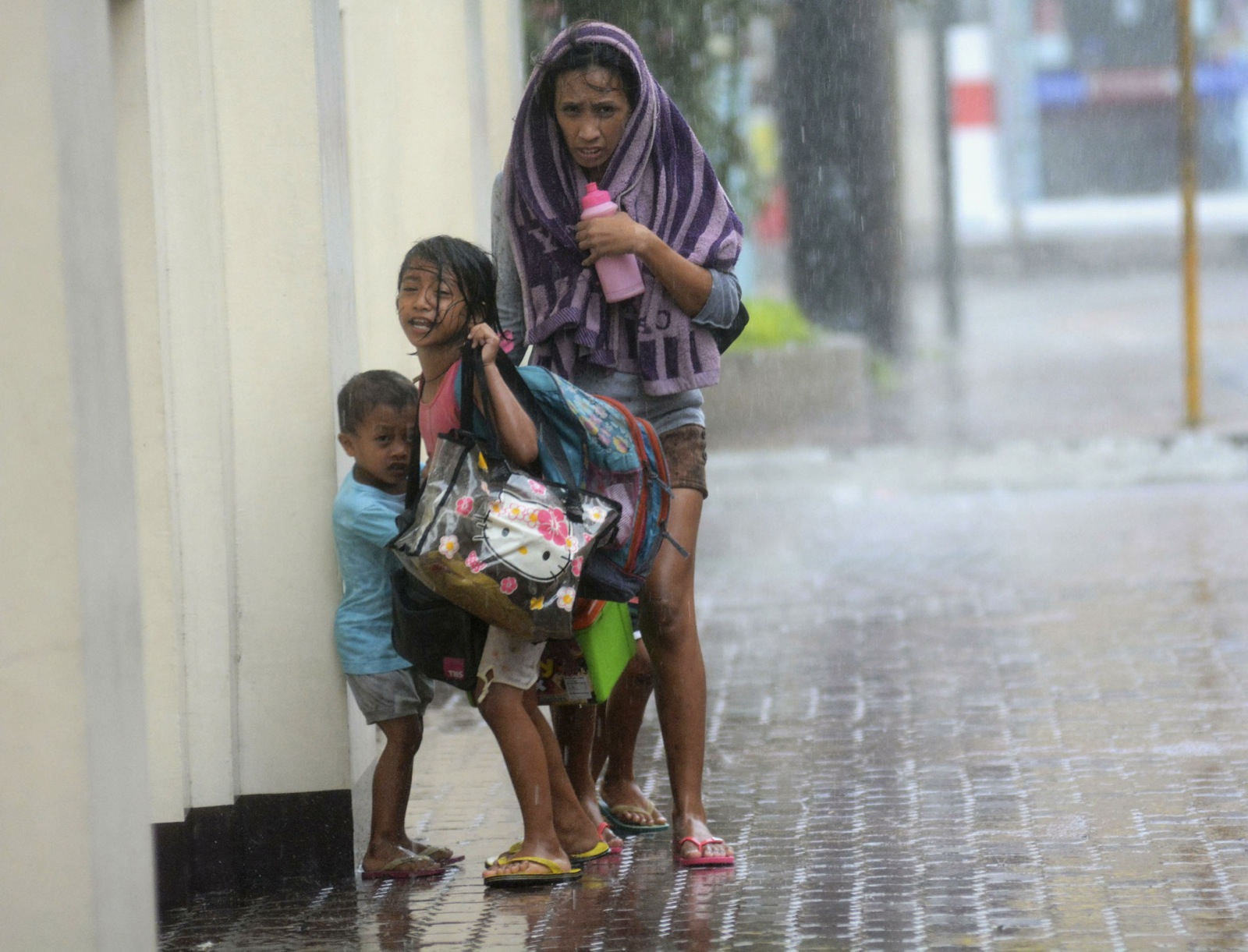 A mother takes refuge with her children as Typhoon Haiyan hits Cebu city, central Philippines. Haiyan, a category-5 super typhoon, bore down on the northern tip of Cebu Province, a popular tourist destination.
REUTERS/Zander Casas
A mother takes refuge with her children as Typhoon Haiyan hits Cebu city, central Philippines. Haiyan, a category-5 super typhoon, bore down on the northern tip of Cebu Province, a popular tourist destination.
REUTERS/Zander Casas Residents stand along a sea wall in Legaspi, Albay province, south of Manila. One of the most intense typhoons on record has so far killed three people.
Charism SAYAT/AFP/Getty Images
Residents stand along a sea wall in Legaspi, Albay province, south of Manila. One of the most intense typhoons on record has so far killed three people.
Charism SAYAT/AFP/Getty Images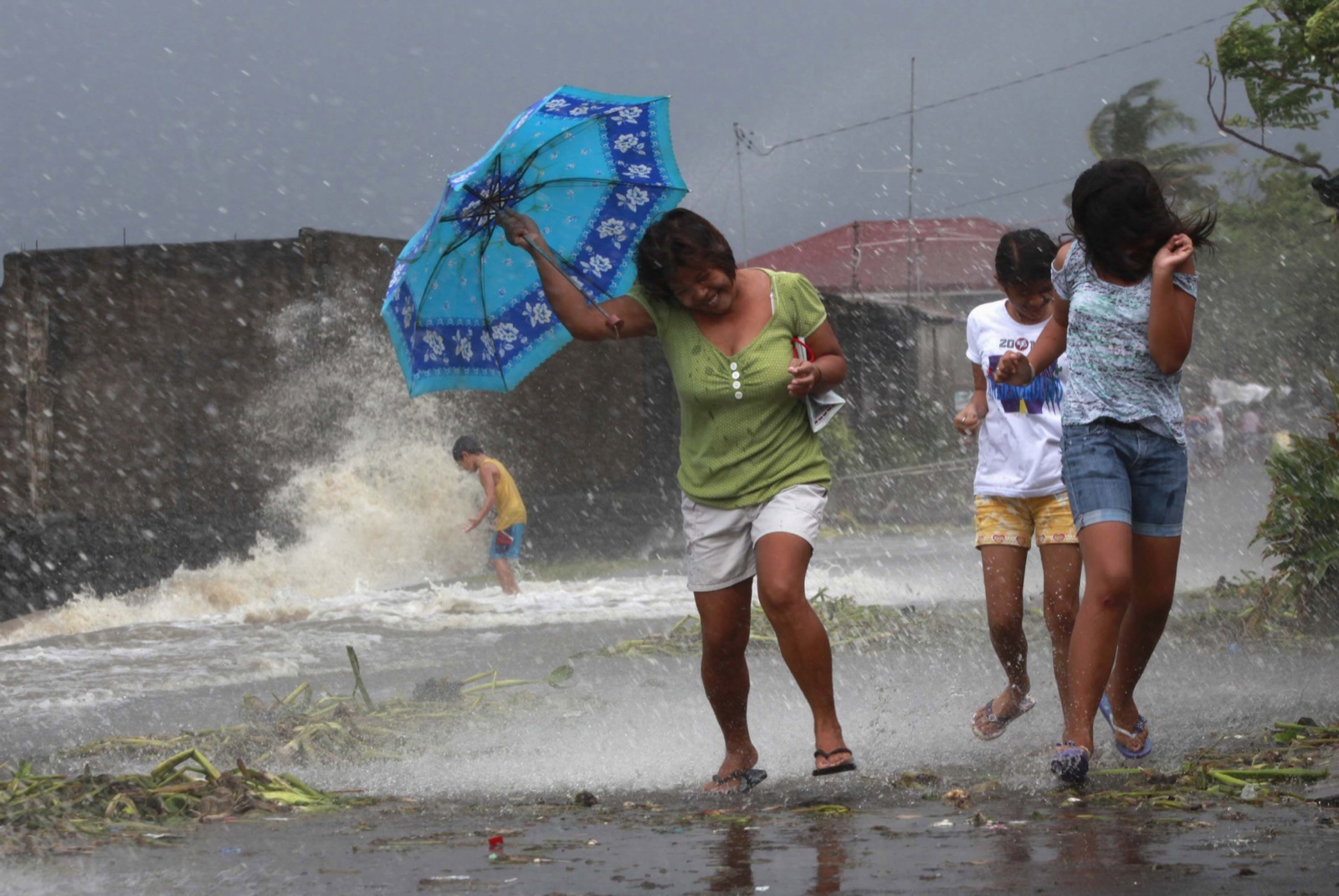 Residents walk along the coastal village of Bayog in Los Banos, Laguna, south of Manila.
REUTERS/Charlie Saceda
Residents walk along the coastal village of Bayog in Los Banos, Laguna, south of Manila.
REUTERS/Charlie Saceda Debris floats on a flooded road as strong winds and rain continues to batter buildings after Typhoon Haiyan hit Tacloban city, Leyte province, in this still image from video.
REUTERS/ABS-CBN via Reuters TV
Debris floats on a flooded road as strong winds and rain continues to batter buildings after Typhoon Haiyan hit Tacloban city, Leyte province, in this still image from video.
REUTERS/ABS-CBN via Reuters TV Residents living near the slopes of Mayon volcano are evacuated to public schools by police. The storm slammed into central Philippine provinces, with one weather expert warning, "There will be catastrophic damage."
AP Photo/Nelson Salting
Residents living near the slopes of Mayon volcano are evacuated to public schools by police. The storm slammed into central Philippine provinces, with one weather expert warning, "There will be catastrophic damage."
AP Photo/Nelson Salting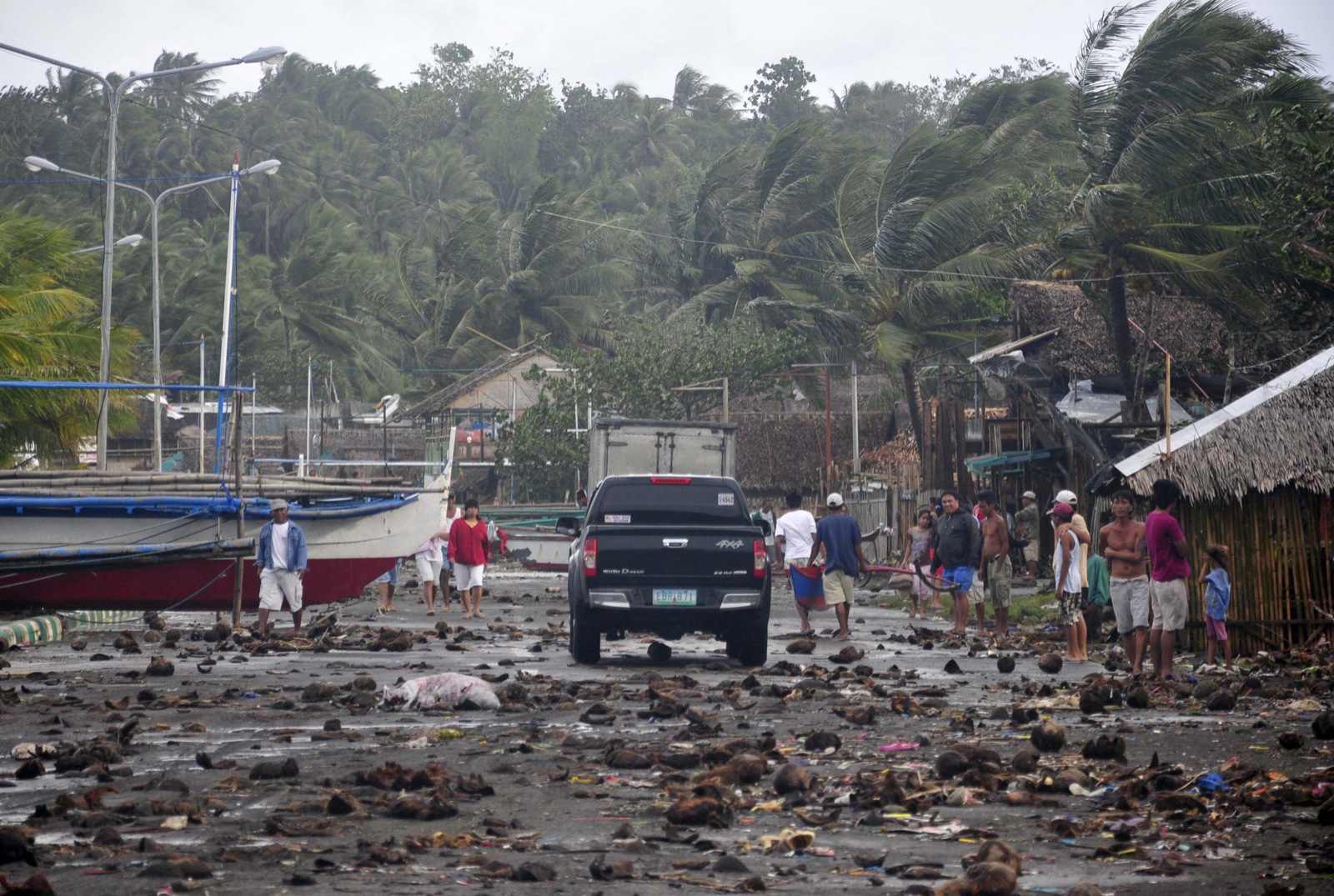 Debris litters the road by the coastal village in Legazpi city following a storm surge brought about by powerful Typhoon Haiyan in Albay province.
AP Photo/Nelson Salting
Debris litters the road by the coastal village in Legazpi city following a storm surge brought about by powerful Typhoon Haiyan in Albay province.
AP Photo/Nelson Salting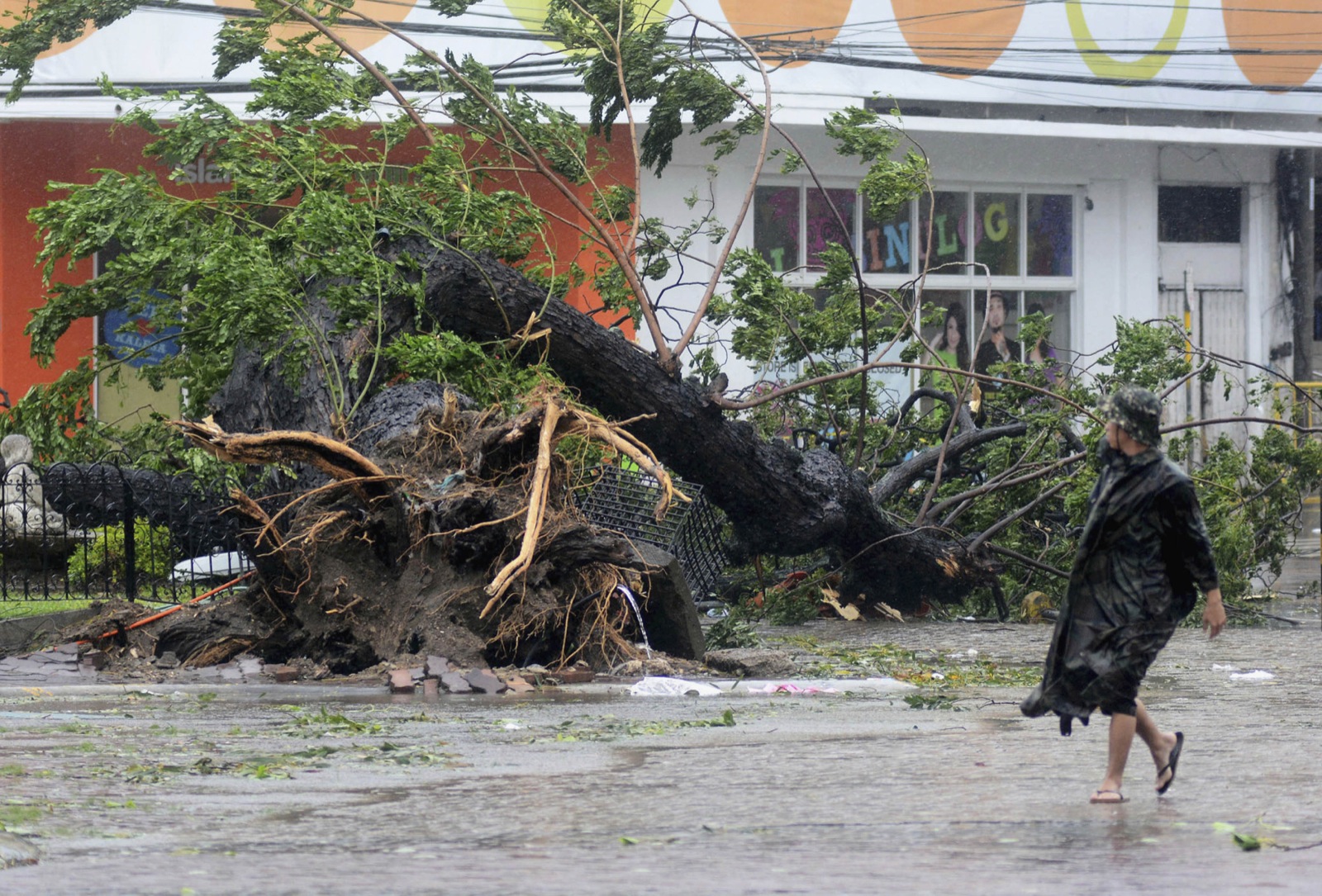 A man walks past a tree uprooted by strong winds brought by super Typhoon Haiyan that hit Cebu city, central Philippines.
REUTERS/Zander Casas
A man walks past a tree uprooted by strong winds brought by super Typhoon Haiyan that hit Cebu city, central Philippines.
REUTERS/Zander Casas Volunteers pack relief goods inside a Department of Social Welfare and Development warehouse before shipping out to devastated provinces hit by Typhoon Haiyan in Manila.
REUTERS/Romeo Ranoco
Volunteers pack relief goods inside a Department of Social Welfare and Development warehouse before shipping out to devastated provinces hit by Typhoon Haiyan in Manila.
REUTERS/Romeo Ranoco{"title":"Typhoon Haiyan in Pictures","image":[{"filename":"AP603321291708.jpg","caption":"An aerial shot Saturday of Tacloban Airport that was devastated by powerful typhoon Haiyan in the Philippines Friday. Meteorologists said Haiyan had maximum sustained winds of 314 kilometers per hour (195 mph) and gusts up to 379 kilometers per hour (235 mph). AP Photo/Bullit Marquez","uploadedURL":"http://cdn.flipboard.com/content/thephotodesk/HeavyWeather/1384000573116-AP603321291708.jpg","thumbURL":"http://cdn.flipboard.com/content/thephotodesk/HeavyWeather/1384000572594-AP603321291708.jpg.png","state":"","$$hashKey":"01U"},{"filename":"2013-11-09T120131Z_696623072_GM1E9B91JG301_RTRMADP_3_PHILIPPINES-TYPHOON.JPG","caption":"Survivors assess the damage after super Typhoon Haiyan battered Tacloban city. \nREUTERS/Romeo Ranoco","uploadedURL":"http://cdn.flipboard.com/content/thephotodesk/HeavyWeather/1384000572966-2013-11-09T120131Z_696623072_GM1E9B91JG301_RTRMADP_3_PHILIPPINES-TYPHOON.JPG","thumbURL":"http://cdn.flipboard.com/content/thephotodesk/HeavyWeather/1384000572576-2013-11-09T120131Z_696623072_GM1E9B91JG301_RTRMADP_3_PHILIPPINES-TYPHOON.JPG.png","state":"","$$hashKey":"01Q"},{"filename":"AP496512250968.jpg","caption":"A vehicle lies amid debris caused by powerful typhoon Haiyan that hit Tacloban city, in Leyte province in central Philippines. \nAP Photo/Bullit Marquez","uploadedURL":"http://cdn.flipboard.com/content/thephotodesk/HeavyWeather/1384000573063-AP496512250968.jpg","thumbURL":"http://cdn.flipboard.com/content/thephotodesk/HeavyWeather/1384000572583-AP496512250968.jpg.png","state":"","$$hashKey":"01S"},{"filename":"2013-11-09T100421Z_1557895686_GM1E9B91DYX01_RTRMADP_3_PHILIPPINES-TYPHOON.JPG","caption":"Soldiers walks past the damaged area of an airport after super Typhoon Haiyan battered Tacloban city. \nREUTERS/Romeo Ranoco","uploadedURL":"http://cdn.flipboard.com/content/thephotodesk/HeavyWeather/1384000572317-2013-11-09T100421Z_1557895686_GM1E9B91DYX01_RTRMADP_3_PHILIPPINES-TYPHOON.JPG","thumbURL":"http://cdn.flipboard.com/content/thephotodesk/HeavyWeather/1384000571537-2013-11-09T100421Z_1557895686_GM1E9B91DYX01_RTRMADP_3_PHILIPPINES-TYPHOON.JPG.png","state":"","$$hashKey":"01C"},{"filename":"2013-11-09T114635Z_599873353_GM1E9B91IFV01_RTRMADP_3_PHILIPPINES-TYPHOON.JPG","caption":"Debris litters a damaged airport. Possibly the strongest typhoon ever to hit land, Haiyan devastated the central Philippine city of Tacloban, killing at least 100 people. \nREUTERS/Erik De Castro","uploadedURL":"http://cdn.flipboard.com/content/thephotodesk/HeavyWeather/1384000572924-2013-11-09T114635Z_599873353_GM1E9B91IFV01_RTRMADP_3_PHILIPPINES-TYPHOON.JPG","thumbURL":"http://cdn.flipboard.com/content/thephotodesk/HeavyWeather/1384000572573-2013-11-09T114635Z_599873353_GM1E9B91IFV01_RTRMADP_3_PHILIPPINES-TYPHOON.JPG.png","state":"","$$hashKey":"01O"},{"filename":"2013-11-09T113254Z_1_CBRE9A80W3200_RTROPTP_4_PHILIPPINES-TYPHOON.JPG","caption":"Damaged houses near the airport. \nREUTERS/Romeo Ranoco","uploadedURL":"http://cdn.flipboard.com/content/thephotodesk/HeavyWeather/1384000572413-2013-11-09T113254Z_1_CBRE9A80W3200_RTROPTP_4_PHILIPPINES-TYPHOON.JPG","thumbURL":"http://cdn.flipboard.com/content/thephotodesk/HeavyWeather/1384000571529-2013-11-09T113254Z_1_CBRE9A80W3200_RTROPTP_4_PHILIPPINES-TYPHOON.JPG.png","state":"","$$hashKey":"01K"},{"filename":"2013-11-09T113254Z_1_CBRE9A80W3000_RTROPTP_4_PHILIPPINES-TYPHOON.JPG","caption":"Residents look at the damaged village hall after Typhoon Haiyan hit Janiuay, in Iloilo province in central Philippines. \nREUTERS/Nereo Lujan","uploadedURL":"http://cdn.flipboard.com/content/thephotodesk/HeavyWeather/1384000573021-2013-11-09T113254Z_1_CBRE9A80W3000_RTROPTP_4_PHILIPPINES-TYPHOON.JPG","thumbURL":"http://cdn.flipboard.com/content/thephotodesk/HeavyWeather/1384000572580-2013-11-09T113254Z_1_CBRE9A80W3000_RTROPTP_4_PHILIPPINES-TYPHOON.JPG.png","state":"","$$hashKey":"01I"},{"filename":"2013-11-09T112408Z_1905087963_GM1E9B91HLM01_RTRMADP_3_PHILIPPINES-TYPHOON.JPG","caption":"Residents walks past a truck that slammed into a tree after a super Typhoon Haiyan battered Tacloban city.\nREUTERS/Romeo Ranoco","uploadedURL":"http://cdn.flipboard.com/content/thephotodesk/HeavyWeather/1384000572260-2013-11-09T112408Z_1905087963_GM1E9B91HLM01_RTRMADP_3_PHILIPPINES-TYPHOON.JPG","thumbURL":"http://cdn.flipboard.com/content/thephotodesk/HeavyWeather/1384000571524-2013-11-09T112408Z_1905087963_GM1E9B91HLM01_RTRMADP_3_PHILIPPINES-TYPHOON.JPG.png","state":"","$$hashKey":"01G"},{"filename":"2013-11-09T101328Z_2074028908_GM1E9B91EGA01_RTRMADP_3_PHILIPPINES-TYPHOON.JPG","caption":"Children play near electric posts that were damaged after super Typhoon Haiyan battered Tacloban city. \nREUTERS/Romeo Ranoco","uploadedURL":"http://cdn.flipboard.com/content/thephotodesk/HeavyWeather/1384000572883-2013-11-09T101328Z_2074028908_GM1E9B91EGA01_RTRMADP_3_PHILIPPINES-TYPHOON.JPG","thumbURL":"http://cdn.flipboard.com/content/thephotodesk/HeavyWeather/1384000572523-2013-11-09T101328Z_2074028908_GM1E9B91EGA01_RTRMADP_3_PHILIPPINES-TYPHOON.JPG.png","state":"","$$hashKey":"01E"},{"filename":"187437585.jpg","caption":"Women walk past fallen trees and destroyed houses in the aftermath of Super Typhoon Haiyan in Tacloban. \nNOEL CELIS/AFP/Getty Images","uploadedURL":"http://cdn.flipboard.com/content/thephotodesk/HeavyWeather/1384000572379-187437585.jpg","thumbURL":"http://cdn.flipboard.com/content/thephotodesk/HeavyWeather/1384000571508-187437585.jpg.png","state":"","$$hashKey":"018"},{"filename":"2013-11-09T114516Z_2120564227_GM1E9B91IMO01_RTRMADP_3_PHILIPPINES-TYPHOON.JPG","caption":"A survivor waits for a military mercy flight outside a damaged airport after super Typhoon Haiyan battered Tacloban city. \nREUTERS/Erik De Castro","uploadedURL":"http://cdn.flipboard.com/content/thephotodesk/HeavyWeather/1384000574262-2013-11-09T114516Z_2120564227_GM1E9B91IMO01_RTRMADP_3_PHILIPPINES-TYPHOON.JPG","thumbURL":"http://cdn.flipboard.com/content/thephotodesk/HeavyWeather/1384000572586-2013-11-09T114516Z_2120564227_GM1E9B91IMO01_RTRMADP_3_PHILIPPINES-TYPHOON.JPG.png","state":"","$$hashKey":"01M"},{"filename":"187331482.jpg","caption":"A resident, right, walks past high waves pounding the sea wall amid strong winds as Typhoon Haiyan hit the city of Legaspi, Albay province, south of Manila on Friday. One of the most intense typhoons on record terrified millions as monster winds tore roofs off buildings and giant waves washed away flimsy homes.\nCharism SAYAT/AFP/Getty Images","uploadedURL":"http://cdn.flipboard.com/content/thephotodesk/HeavyWeather/1383926174030-187331482.jpg","thumbURL":"http://cdn.flipboard.com/content/thephotodesk/HeavyWeather/1383926173355-187331482.jpg.png","state":"","$$hashKey":"01F"},{"filename":"2013-11-08T131808Z_4_CBRE9A70VOS00_RTROPTP_3_US-PHILIPPINES-TYPHOON.JPG","caption":"Super Typhoon Haiyan is seen approaching the Philippines in this Japan Meteorological Agency handout image taken Thursday. Authorities in the Philippines grounded air and sea transport on Thursday and urged fishing boats to return to port. With center winds of 215 kph (133 mph) and gusts of up to 250 kph, the storm, was rated as category 5. \nREUTERS/Japan Meteorological Agency/NOAA/Handout","uploadedURL":"http://cdn.flipboard.com/content/thephotodesk/HeavyWeather/1383926174047-2013-11-08T131808Z_4_CBRE9A70VOS00_RTROPTP_3_US-PHILIPPINES-TYPHOON.JPG","thumbURL":"http://cdn.flipboard.com/content/thephotodesk/HeavyWeather/1383926173351-2013-11-08T131808Z_4_CBRE9A70VOS00_RTROPTP_3_US-PHILIPPINES-TYPHOON.JPG.png","state":"","$$hashKey":"01V"},{"filename":"2013-11-08T131022Z_3_GM1E9B80VUE01_RTRMADP_TRX_PHILIPPINES-TYPHOON.JPG","caption":"Fishermen secure their boats in anticipation of the arrival of Typhoon Haiyan near Manila Bay, Friday. \nREUTERS/Erik De Castro","uploadedURL":"http://cdn.flipboard.com/content/thephotodesk/HeavyWeather/1383926174009-2013-11-08T131022Z_3_GM1E9B80VUE01_RTRMADP_TRX_PHILIPPINES-TYPHOON.JPG","thumbURL":"http://cdn.flipboard.com/content/thephotodesk/HeavyWeather/1383926173364-2013-11-08T131022Z_3_GM1E9B80VUE01_RTRMADP_TRX_PHILIPPINES-TYPHOON.JPG.png","state":"","$$hashKey":"01J"},{"filename":"2013-11-08T131808Z_4_CBRE9A70VOO00_RTROPTP_3_PHILIPPINES-TYPHOON.JPG","caption":"A mother takes refuge with her children as Typhoon Haiyan hits Cebu city, central Philippines. Haiyan, a category-5 super typhoon, bore down on the northern tip of Cebu Province, a popular tourist destination. \nREUTERS/Zander Casas","uploadedURL":"http://cdn.flipboard.com/content/thephotodesk/HeavyWeather/1383926174140-2013-11-08T131808Z_4_CBRE9A70VOO00_RTROPTP_3_PHILIPPINES-TYPHOON.JPG","thumbURL":"http://cdn.flipboard.com/content/thephotodesk/HeavyWeather/1383926173376-2013-11-08T131808Z_4_CBRE9A70VOO00_RTROPTP_3_PHILIPPINES-TYPHOON.JPG.png","state":"","$$hashKey":"01T"},{"filename":"187331509.jpg","caption":"Residents stand along a sea wall in Legaspi, Albay province, south of Manila. One of the most intense typhoons on record has so far killed three people. \nCharism SAYAT/AFP/Getty Images","uploadedURL":"http://cdn.flipboard.com/content/thephotodesk/HeavyWeather/1383926173955-187331509.jpg","thumbURL":"http://cdn.flipboard.com/content/thephotodesk/HeavyWeather/1383926173297-187331509.jpg.png","state":"","$$hashKey":"01H"},{"filename":"2013-11-08T131808Z_1_CBRE9A710YA00_RTROPTP_4_PHILIPPINES-TYPHOON.JPG","caption":"Residents walk along the coastal village of Bayog in Los Banos, Laguna, south of Manila. \nREUTERS/Charlie Saceda","uploadedURL":"http://cdn.flipboard.com/content/thephotodesk/HeavyWeather/1383926174246-2013-11-08T131808Z_1_CBRE9A710YA00_RTROPTP_4_PHILIPPINES-TYPHOON.JPG","thumbURL":"http://cdn.flipboard.com/content/thephotodesk/HeavyWeather/1383926173379-2013-11-08T131808Z_1_CBRE9A710YA00_RTROPTP_4_PHILIPPINES-TYPHOON.JPG.png","state":"","$$hashKey":"01P"},{"filename":"2013-11-08T131808Z_4_CBRE9A707WO00_RTROPTP_4_PHILIPPINES-TYPHOON.JPG","caption":"Debris floats on a flooded road as strong winds and rain continues to batter buildings after Typhoon Haiyan hit Tacloban city, Leyte province, in this still image from video. \nREUTERS/ABS-CBN via Reuters TV","uploadedURL":"http://cdn.flipboard.com/content/thephotodesk/HeavyWeather/1383926173996-2013-11-08T131808Z_4_CBRE9A707WO00_RTROPTP_4_PHILIPPINES-TYPHOON.JPG","thumbURL":"http://cdn.flipboard.com/content/thephotodesk/HeavyWeather/1383926173345-2013-11-08T131808Z_4_CBRE9A707WO00_RTROPTP_4_PHILIPPINES-TYPHOON.JPG.png","state":"","$$hashKey":"01R"},{"filename":"AP356897326561.jpg","caption":"Residents living near the slopes of Mayon volcano are evacuated to public schools by police. The storm slammed into central Philippine provinces, with one weather expert warning, \"There will be catastrophic damage.\" \nAP Photo/Nelson Salting","uploadedURL":"http://cdn.flipboard.com/content/thephotodesk/HeavyWeather/1383926175057-AP356897326561.jpg","thumbURL":"http://cdn.flipboard.com/content/thephotodesk/HeavyWeather/1383926174837-AP356897326561.jpg.png","state":"","$$hashKey":"01X"},{"filename":"AP939337911132.jpg","caption":"Debris litters the road by the coastal village in Legazpi city following a storm surge brought about by powerful Typhoon Haiyan in Albay province. \nAP Photo/Nelson Salting","uploadedURL":"http://cdn.flipboard.com/content/thephotodesk/HeavyWeather/1383926174212-AP939337911132.jpg","thumbURL":"http://cdn.flipboard.com/content/thephotodesk/HeavyWeather/1383926173370-AP939337911132.jpg.png","state":"","$$hashKey":"01Z"},{"filename":"2013-11-08T131022Z_3_GM1E9B81CZC01_RTRMADP_TRX_PHILIPPINES-TYPHOON.JPG","caption":"A man walks past a tree uprooted by strong winds brought by super Typhoon Haiyan that hit Cebu city, central Philippines.\nREUTERS/Zander Casas","uploadedURL":"http://cdn.flipboard.com/content/thephotodesk/HeavyWeather/1383926174065-2013-11-08T131022Z_3_GM1E9B81CZC01_RTRMADP_TRX_PHILIPPINES-TYPHOON.JPG","thumbURL":"http://cdn.flipboard.com/content/thephotodesk/HeavyWeather/1383926173368-2013-11-08T131022Z_3_GM1E9B81CZC01_RTRMADP_TRX_PHILIPPINES-TYPHOON.JPG.png","state":"","$$hashKey":"01N"},{"filename":"2013-11-08T131022Z_3_GM1E9B817DZ01_RTRMADP_TRX_PHILIPPINES-TYPHOON.JPG","caption":"Volunteers pack relief goods inside a Department of Social Welfare and Development warehouse before shipping out to devastated provinces hit by Typhoon Haiyan in Manila.\nREUTERS/Romeo Ranoco","uploadedURL":"http://cdn.flipboard.com/content/thephotodesk/HeavyWeather/1383926174103-2013-11-08T131022Z_3_GM1E9B817DZ01_RTRMADP_TRX_PHILIPPINES-TYPHOON.JPG","thumbURL":"http://cdn.flipboard.com/content/thephotodesk/HeavyWeather/1383926173374-2013-11-08T131022Z_3_GM1E9B817DZ01_RTRMADP_TRX_PHILIPPINES-TYPHOON.JPG.png","state":"","$$hashKey":"01L"}],"type":"gallery"}
 An aerial shot Saturday of Tacloban Airport that was devastated by powerful typhoon Haiyan in the Philippines Friday. Meteorologists said Haiyan had maximum sustained winds of 314 kilometers per hour (195 mph) and gusts up to 379 kilometers per hour (235 mph). AP Photo/Bullit Marquez
An aerial shot Saturday of Tacloban Airport that was devastated by powerful typhoon Haiyan in the Philippines Friday. Meteorologists said Haiyan had maximum sustained winds of 314 kilometers per hour (195 mph) and gusts up to 379 kilometers per hour (235 mph). AP Photo/Bullit Marquez Survivors assess the damage after super Typhoon Haiyan battered Tacloban city.
REUTERS/Romeo Ranoco
Survivors assess the damage after super Typhoon Haiyan battered Tacloban city.
REUTERS/Romeo Ranoco A vehicle lies amid debris caused by powerful typhoon Haiyan that hit Tacloban city, in Leyte province in central Philippines.
AP Photo/Bullit Marquez
A vehicle lies amid debris caused by powerful typhoon Haiyan that hit Tacloban city, in Leyte province in central Philippines.
AP Photo/Bullit Marquez Soldiers walks past the damaged area of an airport after super Typhoon Haiyan battered Tacloban city.
REUTERS/Romeo Ranoco
Soldiers walks past the damaged area of an airport after super Typhoon Haiyan battered Tacloban city.
REUTERS/Romeo Ranoco Debris litters a damaged airport. Possibly the strongest typhoon ever to hit land, Haiyan devastated the central Philippine city of Tacloban, killing at least 100 people.
REUTERS/Erik De Castro
Debris litters a damaged airport. Possibly the strongest typhoon ever to hit land, Haiyan devastated the central Philippine city of Tacloban, killing at least 100 people.
REUTERS/Erik De Castro Damaged houses near the airport.
REUTERS/Romeo Ranoco
Damaged houses near the airport.
REUTERS/Romeo Ranoco Residents look at the damaged village hall after Typhoon Haiyan hit Janiuay, in Iloilo province in central Philippines.
REUTERS/Nereo Lujan
Residents look at the damaged village hall after Typhoon Haiyan hit Janiuay, in Iloilo province in central Philippines.
REUTERS/Nereo Lujan Residents walks past a truck that slammed into a tree after a super Typhoon Haiyan battered Tacloban city.
REUTERS/Romeo Ranoco
Residents walks past a truck that slammed into a tree after a super Typhoon Haiyan battered Tacloban city.
REUTERS/Romeo Ranoco Children play near electric posts that were damaged after super Typhoon Haiyan battered Tacloban city.
REUTERS/Romeo Ranoco
Children play near electric posts that were damaged after super Typhoon Haiyan battered Tacloban city.
REUTERS/Romeo Ranoco Women walk past fallen trees and destroyed houses in the aftermath of Super Typhoon Haiyan in Tacloban.
NOEL CELIS/AFP/Getty Images
Women walk past fallen trees and destroyed houses in the aftermath of Super Typhoon Haiyan in Tacloban.
NOEL CELIS/AFP/Getty Images A survivor waits for a military mercy flight outside a damaged airport after super Typhoon Haiyan battered Tacloban city.
REUTERS/Erik De Castro
A survivor waits for a military mercy flight outside a damaged airport after super Typhoon Haiyan battered Tacloban city.
REUTERS/Erik De Castro A resident, right, walks past high waves pounding the sea wall amid strong winds as Typhoon Haiyan hit the city of Legaspi, Albay province, south of Manila on Friday. One of the most intense typhoons on record terrified millions as monster winds tore roofs off buildings and giant waves washed away flimsy homes.
Charism SAYAT/AFP/Getty Images
A resident, right, walks past high waves pounding the sea wall amid strong winds as Typhoon Haiyan hit the city of Legaspi, Albay province, south of Manila on Friday. One of the most intense typhoons on record terrified millions as monster winds tore roofs off buildings and giant waves washed away flimsy homes.
Charism SAYAT/AFP/Getty Images Super Typhoon Haiyan is seen approaching the Philippines in this Japan Meteorological Agency handout image taken Thursday. Authorities in the Philippines grounded air and sea transport on Thursday and urged fishing boats to return to port. With center winds of 215 kph (133 mph) and gusts of up to 250 kph, the storm, was rated as category 5.
REUTERS/Japan Meteorological Agency/NOAA/Handout
Super Typhoon Haiyan is seen approaching the Philippines in this Japan Meteorological Agency handout image taken Thursday. Authorities in the Philippines grounded air and sea transport on Thursday and urged fishing boats to return to port. With center winds of 215 kph (133 mph) and gusts of up to 250 kph, the storm, was rated as category 5.
REUTERS/Japan Meteorological Agency/NOAA/Handout Fishermen secure their boats in anticipation of the arrival of Typhoon Haiyan near Manila Bay, Friday.
REUTERS/Erik De Castro
Fishermen secure their boats in anticipation of the arrival of Typhoon Haiyan near Manila Bay, Friday.
REUTERS/Erik De Castro A mother takes refuge with her children as Typhoon Haiyan hits Cebu city, central Philippines. Haiyan, a category-5 super typhoon, bore down on the northern tip of Cebu Province, a popular tourist destination.
REUTERS/Zander Casas
A mother takes refuge with her children as Typhoon Haiyan hits Cebu city, central Philippines. Haiyan, a category-5 super typhoon, bore down on the northern tip of Cebu Province, a popular tourist destination.
REUTERS/Zander Casas Residents stand along a sea wall in Legaspi, Albay province, south of Manila. One of the most intense typhoons on record has so far killed three people.
Charism SAYAT/AFP/Getty Images
Residents stand along a sea wall in Legaspi, Albay province, south of Manila. One of the most intense typhoons on record has so far killed three people.
Charism SAYAT/AFP/Getty Images Residents walk along the coastal village of Bayog in Los Banos, Laguna, south of Manila.
REUTERS/Charlie Saceda
Residents walk along the coastal village of Bayog in Los Banos, Laguna, south of Manila.
REUTERS/Charlie Saceda Debris floats on a flooded road as strong winds and rain continues to batter buildings after Typhoon Haiyan hit Tacloban city, Leyte province, in this still image from video.
REUTERS/ABS-CBN via Reuters TV
Debris floats on a flooded road as strong winds and rain continues to batter buildings after Typhoon Haiyan hit Tacloban city, Leyte province, in this still image from video.
REUTERS/ABS-CBN via Reuters TV Residents living near the slopes of Mayon volcano are evacuated to public schools by police. The storm slammed into central Philippine provinces, with one weather expert warning, "There will be catastrophic damage."
AP Photo/Nelson Salting
Residents living near the slopes of Mayon volcano are evacuated to public schools by police. The storm slammed into central Philippine provinces, with one weather expert warning, "There will be catastrophic damage."
AP Photo/Nelson Salting Debris litters the road by the coastal village in Legazpi city following a storm surge brought about by powerful Typhoon Haiyan in Albay province.
AP Photo/Nelson Salting
Debris litters the road by the coastal village in Legazpi city following a storm surge brought about by powerful Typhoon Haiyan in Albay province.
AP Photo/Nelson Salting A man walks past a tree uprooted by strong winds brought by super Typhoon Haiyan that hit Cebu city, central Philippines.
REUTERS/Zander Casas
A man walks past a tree uprooted by strong winds brought by super Typhoon Haiyan that hit Cebu city, central Philippines.
REUTERS/Zander Casas Volunteers pack relief goods inside a Department of Social Welfare and Development warehouse before shipping out to devastated provinces hit by Typhoon Haiyan in Manila.
REUTERS/Romeo Ranoco
Volunteers pack relief goods inside a Department of Social Welfare and Development warehouse before shipping out to devastated provinces hit by Typhoon Haiyan in Manila.
REUTERS/Romeo Ranoco